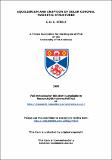Files in this item
Equilibrium and eruption of solar coronal magnetic structures
Item metadata
| dc.contributor.advisor | Priest, E. R. (Eric Ronald) | |
| dc.contributor.author | Steele, C. D. C. | |
| dc.coverage.spatial | 161 p. | en_US |
| dc.date.accessioned | 2014-04-29T10:26:52Z | |
| dc.date.available | 2014-04-29T10:26:52Z | |
| dc.date.issued | 1990 | |
| dc.identifier | uk.bl.ethos.278125 | |
| dc.identifier.uri | https://hdl.handle.net/10023/4654 | |
| dc.description.abstract | In this thesis magnetostatic and thermal equilibria of several coronal magnetic structures are considered. A model is set up for the eruption of a prominence (modelled as a twisted flux tube) magnetically coupled to a coronal mass ejection (an overlying void and magnetic bubble). Two different prominence models are considered. In one a globally stable equilibrium becomes unstable and, in the other, equilibrium ceases to exist. In both cases, the components accelerate upwards before reaching constant velocities in a manner consistent with observations. A cylindrically symmetric magnetic arcade in equilibrium with its axis on the photosphere is subjected to a base pressure perturbation. The perturbation is examined with the aim of seeking equilibrium configurations close to the original equilibrium. It is found that equilibria can only be found when the integral of the excess base pressure is zero. For an initial arcade whose field increases linearly with radial distance from the axis, neighbouring equilibria have been found. Equations of thermal equilibrium along coronal loops with footpoint temperatures of 2 x 10⁴K are solved. Three fundamentally different categories of solution are found, namely hot loops, (corresponding to the hot corona), cool loops (relevant to fibrils, cool cores, and active-region prominences) and hot-cool loops with cool summits but much hotter parts between the summit and the footpoints. Quiescent prominences may be modelled as hot-cool loops inclined to the prominence axis. Furthermore, warm loops at intermediate summit temperatures (8 x 10⁴K to 4 x 10⁵ K) can exist, but the observed differential emission measure suggests these are uncommon. Thermal catastrophe may occur when the loop length or pressure is too small. Many loops can be superimposed to form a coronal arcade. Two types of arcade are considered - one has its axis on the photosphere; the other is isobaric and has its axis below the photosphere. In both cases, cool material can exist high in the corona as is observed for prominences. | en_US |
| dc.language.iso | en | en_US |
| dc.publisher | University of St Andrews | |
| dc.rights | Creative Commons Attribution-NonCommercial-NoDerivatives 4.0 International | |
| dc.rights.uri | http://creativecommons.org/licenses/by-nc-nd/4.0/ | |
| dc.subject.lcc | QA927.S8 | |
| dc.title | Equilibrium and eruption of solar coronal magnetic structures | en_US |
| dc.type | Thesis | en_US |
| dc.contributor.sponsor | Science and Engineering Research Council (SERC) | en_US |
| dc.type.qualificationlevel | Doctoral | en_US |
| dc.type.qualificationname | PhD Doctor of Philosophy | en_US |
| dc.publisher.institution | The University of St Andrews | en_US |
This item appears in the following Collection(s)
Except where otherwise noted within the work, this item's licence for re-use is described as Creative Commons Attribution-NonCommercial-NoDerivatives 4.0 International
Items in the St Andrews Research Repository are protected by copyright, with all rights reserved, unless otherwise indicated.


